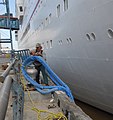Category:US National Archives series: Photographs Relating to Disasters and Emergency Management Programs, Activities, and Officials, 1998 - 9/26/2016
This series consists of photographs documenting the physical and social impact of events, in the United States and U.S. territories, that were designated by the federal government as disasters, including accidental explosions, earthquakes, floods, hurricanes, ice storms, mud slides, tornadoes, tropical storms, typhoons, volcanic eruptions, wild fires, and incidents of terrorism. Extensively documented, as well, are Federal Emergency Management Agency's (FEMA) responses to these events, involving coordination of federal, state, and local resources for, and direct sponsorship of, a range of operations aimed at evacuation, search and rescue, clearance, and cleanup; provision of emergency food, water, shelter, and medical services; restoration of basic infrastructure; and rebuilding of homes, businesses, and communities. This series contains a large number of graphics advertising and promoting FEMA.
There is coverage (more than 1,400 images) of the aftermath of the September 11, 2001 terrorist attacks on the World Trade Center in New York City and the Pentagon in Virginia. Numerous views show the nature and extent of the devastation, the massive mobilization of personnel and equipment for search, rescue, and cleanup operations, the progress of the rebuilding effort for the damaged section of the Pentagon, visits and speeches by national, state, and local political leaders and other dignitaries, and tributes ranging from makeshift memorials near New York City's Ground Zero to formal commemorations on anniversaries of the tragedy.
Among other disasters, and FEMA responses thereto, covered in this series are Hurricane Andrew, striking Florida in August, 1992; the widespread flooding in Missouri, Illinois, Iowa, and other Midwestern states in July, 1993; the Northridge, California earthquake of January, 1994; the bombing of the Alfred P. Murrah Federal Building in Oklahoma City in April, 1995; Typhoon Paka (December, 1997) and Super Typhoon Pongsona (December, 2002), with their impact on Guam; El Nino-related flooding and mud slides in California in February, 1998; Hurricane Floyd, hitting Virginia, North Carolina, Delaware, and other states in September, 1999; the forest fires in Santa Fe National Forest in May, 2000; Hurricane Lili, leaving its mark on Louisiana and Texas in October, 2002; the tornadoes striking western Tennessee in May, 2003; Hurricane Isabel, affecting many areas of the East Coast in September, 2003; Hurricanes Katrina and Rita, largely striking Louisiana, 2005; Hurricane Dolly, striking southern Texas in July, 2008; Tropical Storm Fay, striking Florida in August, 2008; Hurricane Gustav, largely striking Louisiana in September, 2008; Hurricane Ike, largely striking Texas in September, 2008; the Red River flooding in Minnesota and North Dakota in 2009; the American Samoa tsunami in 2009; the tornado outbreak in the Southeast United States from April 25 to 28, 2011; the EF5 multiple-vortex tornado that struck Joplin, Missouri in May, 2011; Hurricane Irene in August, 2011; Tropical Storm Lee in September, 2011; Tropical Storm Debby in June, 2012; Hurricane Isaacs in August, 2012; Hurricane Sandy in October, 2012; the 2013 Moore, Oklahoma tornado; the 2014 Elk River chemical spill in West Virginia; the 2014 South Napa earthquake; and the tornado outbreaks from April 27 to 30 and June 16 to 18, 2014; severe storms effecting Texas, Wyoming, South Carolina, and the Pine Ridge Reservation, Typhoon Soudelor in the Commonwealth of Northern Mariana Islands (CMNI) in 2015; Severe storms and flooding in Louisiana, Texas, and West Virginia in 2016.
FEMA Directors James Lee Witt, Joe M. Allbaugh, Michael D. Brown, R. David Paulison, Nancy L. Ward (acting) and W. Craig Fugate are among the agency headquarters and field officials shown in inspection, meeting, Congressional testimony, and portrait settings. There is also coverage of Presidential visits to disaster sites, such as President George Bush's meeting with California residents in the aftermath of the October, 1989 Loma Prieta earthquake, President Bill Clinton's visit to Jefferson County, Alabama to survey damage and interview survivors after the April, 1998 tornadoes; and President George W. Bush's visit to the World Trade Center ruins three days after the 9/11 attacks. In addition, there are images of President Barack Obama and Department of Homeland Security Secretary Janet Napolitano. Along with disaster-specific coverage in this series, considerable attention is devoted to FEMA's ongoing disaster preparedness programs, including promotion of damage mitigation measures in design, construction, and modification of structures and systems, and training of emergency management leaders from around the country at the National Emergency Training Center in Emmitsburg, Maryland.
Press conferences, policy conferences, and other FEMA headquarters events are also featured in this series, as are such non-FEMA ceremonies as the Native American parade commemorating the opening of the Smithsonian Institution's National Museum of the American Indian on the National Mall in 2004. Photographs in this series represent the work of more than three dozen photographers, including FEMA photographic specialists as well as other public information personnel from headquarters and field offices. Among the most frequent contributors are Liz Roll, Andrea Booher, Dave Saville, Dave Gatley, Jocelyn Augustino, Larry Lerner, Michael Rieger, Bri Rodriguez, Kevin Galvin, Robert Eplett, Jason Pack, Bob Epstein, John Shea, Bill Koplitz, Mark Wolfe and Win Henderson. The paper materials provide documentation for the photographs.
Media in category "US National Archives series: Photographs Relating to Disasters and Emergency Management Programs, Activities, and Officials, 1998 - 9/26/2016"
The following 200 files are in this category, out of 978 total.
(previous page) (next page)-
Apartment building in New Orleans flooded in Hurricane Isaac, 8 September 2012.jpg 4,288 × 2,848; 5.48 MB





































































































































































































